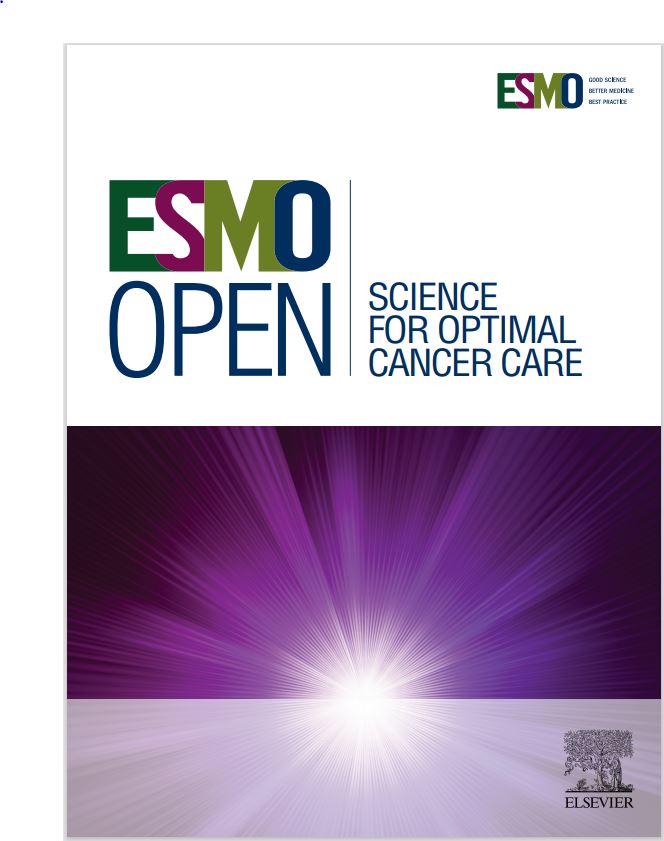Genomic and transcriptomic analyses of residual invasive triple-negative breast cancer after neoadjuvant chemotherapy in the prospective MIRINAE trial (a randomized phase II trial of adjuvant atezolizumab plus capecitabine compared to capecitabine; KCSG-BR18-21)
IF 8.3
2区 医学
Q1 ONCOLOGY
引用次数: 0
Abstract
Background
Profiling residual disease after neoadjuvant chemotherapy (NAC) might identify molecular target and tumor microenvironmental features to guide adjuvant therapy. We explored the characteristics of residual triple-negative breast cancer (TNBC) in the prospective MIRINAE trial (KCSG-BR18-21), a phase II study evaluating adjuvant atezolizumab plus capecitabine versus capecitabine in TNBC without pathological complete response after NAC (NCT03756298) through multi-omics analyses.
Materials and methods
Residual TNBC samples were analyzed for tumor-infiltrating lymphocytes (TILs), programmed death-ligand 1 (PD-L1) immunohistochemistry (IHC), and Lunit SCOPE IO immune phenotype (IP). Mutations were assessed by FoundationOne®CDx, and RNAseq was conducted for molecular subtyping and gene expression analyses.
Results
Three hundred and five patients were analyzed, and ypTNM (post-neoadjuvant pathological tumor–node–metastasis) stages were stage I (28.0%), II (48.7%), and III (23.3%). High TILs were observed in 27.1% and PD-L1 IHC was positive in 39.5%. Pathogenic alterations in TP53, phosphatidylinositol 3-kinase (PI3K)/protein kinase B (AKT), and homologous recombination repair (HRR) pathways were observed in 86.3%, 27.1%, and 11.9%. Most patients were basal-like (51.1%) by PAM50, and mesenchymal (MES; 36.7%) or basal-like immune suppressed (BLIS; 30.3%) by TNBC molecular classification. TIL-high group was enriched with the basal-like immune-activated (BLIA) subtype (37.5%), with up-regulation of immune response-related gene sets. Nineteen patients (6.2%) recurred within 6 months of surgery (6.2%), mostly being basal-like (85.7%) or BLIS (64.3%), with low TILs and desert IP. Up-regulations of CCNE1, CD44, and BRD4 along with DNA replication-related gene sets were associated with early recurrence.
Conclusion
Residual TNBCs after standard NAC were predominantly basal-like or MES/BLIS subtypes with variable tumor microenvironment (TME). Early recurrence was associated with immune-cold TME, and further analyses on each treatment arm will provide deeper insights into the role of adjuvant immunotherapy.
前瞻性MIRINAE试验中新辅助化疗后残留侵袭性三阴性乳腺癌的基因组学和转录组学分析(一项辅助atezolizumab加卡培他滨与卡培他滨比较的随机II期试验;KCSG-BR18-21)
背景分析新辅助化疗后残留病变(NAC)可以识别分子靶点和肿瘤微环境特征,指导辅助治疗。我们在前瞻性MIRINAE试验(KCSG-BR18-21)中探讨了残留三阴性乳腺癌(TNBC)的特征,这是一项II期研究,通过多组学分析,评估阿特唑单抗联合卡培他滨与卡培他滨在NAC (NCT03756298)后无病理完全缓解的TNBC中的疗效。材料和方法对残留TNBC样本进行肿瘤浸润淋巴细胞(TILs)、程序性死亡配体1 (PD-L1)免疫组化(IHC)和Lunit SCOPE IO免疫表型(IP)分析。采用FoundationOne®CDx检测突变,采用RNAseq进行分子分型和基因表达分析。结果共分析了305例患者,ypTNM(新辅助后病理肿瘤-淋巴结转移)分期为I期(28.0%)、II期(48.7%)和III期(23.3%)。27.1%的患者TILs高,39.5%的患者PD-L1 IHC阳性。TP53、磷脂酰肌醇3-激酶(PI3K)/蛋白激酶B (AKT)和同源重组修复(HRR)通路的致病性改变分别为86.3%、27.1%和11.9%。多数患者PAM50为基底样(51.1%),TNBC分子分类为间充质(MES, 36.7%)或基底样免疫抑制(BLIS, 30.3%)。til -高组细胞中基底样免疫激活(BLIA)亚型富集(37.5%),免疫应答相关基因组表达上调。19例(6.2%)术后6个月内复发(6.2%),多为基底样(85.7%)或BLIS(64.3%),低TILs和荒漠IP。CCNE1、CD44和BRD4以及DNA复制相关基因集的上调与早期复发有关。结论标准NAC术后残留tnbc以基底样或MES/BLIS亚型为主,肿瘤微环境(TME)变化较大。早期复发与免疫冷性TME相关,对每个治疗组的进一步分析将为辅助免疫治疗的作用提供更深入的见解。
本文章由计算机程序翻译,如有差异,请以英文原文为准。
求助全文
约1分钟内获得全文
求助全文
来源期刊

ESMO Open
Medicine-Oncology
CiteScore
11.70
自引率
2.70%
发文量
255
审稿时长
10 weeks
期刊介绍:
ESMO Open is the online-only, open access journal of the European Society for Medical Oncology (ESMO). It is a peer-reviewed publication dedicated to sharing high-quality medical research and educational materials from various fields of oncology. The journal specifically focuses on showcasing innovative clinical and translational cancer research.
ESMO Open aims to publish a wide range of research articles covering all aspects of oncology, including experimental studies, translational research, diagnostic advancements, and therapeutic approaches. The content of the journal includes original research articles, insightful reviews, thought-provoking editorials, and correspondence. Moreover, the journal warmly welcomes the submission of phase I trials and meta-analyses. It also showcases reviews from significant ESMO conferences and meetings, as well as publishes important position statements on behalf of ESMO.
Overall, ESMO Open offers a platform for scientists, clinicians, and researchers in the field of oncology to share their valuable insights and contribute to advancing the understanding and treatment of cancer. The journal serves as a source of up-to-date information and fosters collaboration within the oncology community.
 求助内容:
求助内容: 应助结果提醒方式:
应助结果提醒方式:


